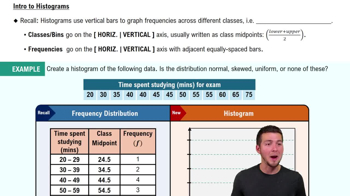Simulating Dice When two dice are rolled, the total is between 2 and 12 inclusive. A student simulates the rolling of two dice by randomly generating numbers between 2 and 12. Does this simulation behave in a way that is similar to actual dice? Why or why not?
Table of contents
- 1. Intro to Stats and Collecting Data1h 14m
- 2. Describing Data with Tables and Graphs1h 55m
- 3. Describing Data Numerically2h 5m
- 4. Probability2h 16m
- 5. Binomial Distribution & Discrete Random Variables3h 6m
- 6. Normal Distribution and Continuous Random Variables2h 11m
- 7. Sampling Distributions & Confidence Intervals: Mean3h 23m
- Sampling Distribution of the Sample Mean and Central Limit Theorem19m
- Distribution of Sample Mean - Excel23m
- Introduction to Confidence Intervals15m
- Confidence Intervals for Population Mean1h 18m
- Determining the Minimum Sample Size Required12m
- Finding Probabilities and T Critical Values - Excel28m
- Confidence Intervals for Population Means - Excel25m
- 8. Sampling Distributions & Confidence Intervals: Proportion1h 12m
- 9. Hypothesis Testing for One Sample3h 29m
- 10. Hypothesis Testing for Two Samples4h 50m
- Two Proportions1h 13m
- Two Proportions Hypothesis Test - Excel28m
- Two Means - Unknown, Unequal Variance1h 3m
- Two Means - Unknown Variances Hypothesis Test - Excel12m
- Two Means - Unknown, Equal Variance15m
- Two Means - Unknown, Equal Variances Hypothesis Test - Excel9m
- Two Means - Known Variance12m
- Two Means - Sigma Known Hypothesis Test - Excel21m
- Two Means - Matched Pairs (Dependent Samples)42m
- Matched Pairs Hypothesis Test - Excel12m
- 11. Correlation1h 6m
- 12. Regression1h 50m
- 13. Chi-Square Tests & Goodness of Fit1h 57m
- 14. ANOVA1h 57m
9. Hypothesis Testing for One Sample
Steps in Hypothesis Testing
Problem 8.1.5
Textbook Question
Identifying H0 and H1
In Exercises 5–8, do the following:
a. Express the original claim in symbolic form.
b. Identify the null and alternative hypotheses.
Landline Phones Claim: Fewer than 10% of homes have only a landline telephone and no wireless phone. Sample data: A survey by the National Center for Health Statistics showed that among 16,113 homes, 5.8% had landline phones without wireless phones.
 Verified step by step guidance
Verified step by step guidance1
Step 1: Understand the problem. The claim is that fewer than 10% of homes have only a landline telephone and no wireless phone. This is a one-tailed hypothesis test because the claim specifies 'fewer than.'
Step 2: Express the original claim in symbolic form. Let p represent the proportion of homes with only a landline telephone and no wireless phone. The claim can be written as: p < 0.10.
Step 3: Define the null hypothesis (H0). The null hypothesis always includes equality or no effect. In this case, H0: p = 0.10.
Step 4: Define the alternative hypothesis (H1). The alternative hypothesis represents the claim being tested. Here, H1: p < 0.10.
Step 5: Summarize the hypotheses. The null hypothesis (H0) is p = 0.10, and the alternative hypothesis (H1) is p < 0.10. These hypotheses will be tested using the sample data provided.
 Verified video answer for a similar problem:
Verified video answer for a similar problem:This video solution was recommended by our tutors as helpful for the problem above
Video duration:
4mPlay a video:
Was this helpful?
Key Concepts
Here are the essential concepts you must grasp in order to answer the question correctly.
Null Hypothesis (H0)
The null hypothesis (H0) is a statement that indicates no effect or no difference, serving as a default position that there is no relationship between two measured phenomena. In this context, it would assert that 10% or more of homes have only a landline phone. It is the hypothesis that researchers aim to test against, and it is typically assumed true until evidence suggests otherwise.
Recommended video:
Guided course

Step 1: Write Hypotheses
Alternative Hypothesis (H1)
The alternative hypothesis (H1) represents the statement that there is an effect or a difference, opposing the null hypothesis. In this scenario, it would claim that fewer than 10% of homes have only a landline phone. This hypothesis is what researchers hope to support through their data analysis, indicating a significant finding if the null hypothesis is rejected.
Recommended video:
Guided course

Step 1: Write Hypotheses
Symbolic Representation
Symbolic representation involves expressing hypotheses using mathematical symbols for clarity and precision. For the given claim, the null hypothesis can be represented as H0: p ≥ 0.10, while the alternative hypothesis can be expressed as H1: p < 0.10, where p denotes the proportion of homes with only a landline phone. This formalization aids in statistical testing and interpretation of results.
Recommended video:
Guided course

Intro to Histograms

 6:21m
6:21mWatch next
Master Step 1: Write Hypotheses with a bite sized video explanation from Patrick
Start learningRelated Videos
Related Practice
Textbook Question
